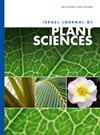In vitro clonal propagation of Billbergia zebrina (Bromeliaceae) and analysis of anatomy and physiology of regenerated plantlets
IF 0.9
4区 生物学
Q4 PLANT SCIENCES
引用次数: 0
Abstract
During in vitro multiplication of horticulture plant species, synthetic cytokinins such as 6-benzylaminopurine (BA) can affect the microshoot formation. Murashige and Skoog culture medium (MS) can also act as a morphogenetic response modulator. The aim was to analyze the effects of BA and a gradient of MS salts on the morphophysiological status of Billbergia zebrina microshoots. Plantlets were cultured with a gradient of MS salts (50%, 100%, 150%, or 200%) supplemented with two BA levels (0 or 13 μM). After 50 days of culture, stomatal parameters, contents of photosynthetic pigments, and chlorophyll fluorescence were assessed. Plantlets cultured in all media without BA presented a low budding rate. In contrast, plantlets cultured with BA showed 100% budding. With 13 μM BA, the leaves presented bigger stomata and wider opening. Plantlets cultured with BA had lower contents of photosynthetic pigments. MS treatments without BA supplementation did not show any change in the pigments’ ratios. Plantlets cultured with BA had lower activity of the water-splitting complex and signs of photoinhibition damage. This resulted in the reduced performance of the photosynthetic apparatus. BA exposure can ensure the inducement of adventitious microshoots. BA at the tested concentration can induce morphophysiological disorders, irrespective of MS salt concentration.凤梨科斑马Billbergia zebrina离体克隆繁殖及再生植株解剖生理分析
在园艺植物物种的体外繁殖过程中,合成的细胞分裂素如6-苄基氨基嘌呤(BA)会影响微芽的形成。Murashige和Skoog培养基(MS)也可以作为形态发生反应调节剂。目的是分析BA和MS盐梯度对斑蝥微芽形态生理状态的影响。用MS盐(50%、100%、150%或200%)梯度培养植株,并补充两种BA水平(0或13μM)。培养50天后,评估气孔参数、光合色素含量和叶绿素荧光。在不含BA的所有培养基中培养的植株出芽率较低。相反,BA培养的植株显示100%出芽。BA浓度为13μM时,叶片气孔较大,开口较宽。BA培养的植株光合色素含量较低。不添加BA的MS处理没有显示出色素比例的任何变化。BA培养的植株具有较低的水分分解复合物活性和光抑制损伤迹象。这导致光合装置的性能降低。BA暴露可以保证不定微芽的诱导。无论MS盐浓度如何,测试浓度的BA都会诱发形态生理障碍。
本文章由计算机程序翻译,如有差异,请以英文原文为准。
求助全文
约1分钟内获得全文
求助全文
来源期刊

Israel Journal of Plant Sciences
生物-植物科学
CiteScore
1.90
自引率
0.00%
发文量
17
审稿时长
>12 weeks
期刊介绍:
The Israel Journal of Plant Sciences is an international journal of extensive scope that publishes special issues dealing with all aspects of plant sciences, including but not limited to: physiology, cell biology, development, botany, genetic
 求助内容:
求助内容: 应助结果提醒方式:
应助结果提醒方式:


